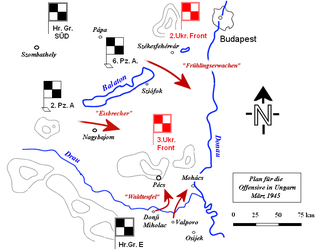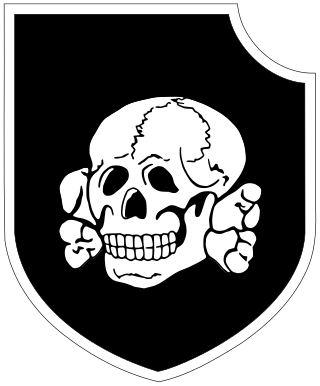Related Research Articles

The Waffen-SS was the combat branch of the Nazi Party's paramilitary Schutzstaffel (SS) organisation. Its formations included men from Nazi Germany, along with volunteers and conscripts from both occupied and unoccupied lands. It was disbanded in May 1945.

The Battle of Korsun–Cherkassy, or the battle of the Korsun–Cherkasy pocket, was a World War II battle fought from 24 January to 16 February 1944 in the course of the Soviet Dnieper–Carpathian offensive in Ukraine following the Korsun–Shevchenkovsky offensive.

Operation Spring Awakening was the last major German offensive of World War II. The operation was referred to in Germany as the Plattensee Offensive and in the Soviet Union as the Balaton Defensive Operation. It took place in Western Hungary on the Eastern Front and lasted from 6 March until 15 March, 1945. The objective was to secure the last significant oil reserves still available to the European Axis powers and prevent the Red Army from advancing towards Vienna. The Germans failed in their objectives.

The 6th Army was a field army unit of the German Wehrmacht during World War II (1939–1945). It was widely remembered for being the most highly decorated German army unit until its defeat by the Red Army at the Battle of Stalingrad in the winter of 1942–1943. It also acquired a reputation for the war crimes that it committed under the command of Field Marshal Walther von Reichenau during Operation Barbarossa.

The SS Division Hitlerjugend or 12th SS Panzer Division "Hitlerjugend" was a German armoured division of the Waffen-SS during World War II. The majority of its junior enlisted men were drawn from members of the Hitler Youth, while the senior NCOs and officers were from other Waffen-SS divisions.

The 3rd SS Panzer Division "Totenkopf" was an elite division of the Waffen-SS of Nazi Germany during World War II, formed from the Standarten of the SS-TV. Its name, Totenkopf, is German for "death's head" – the skull and crossbones symbol – and it is thus sometimes referred to as the Death's Head Division.

The 5th SS Panzer Division Wiking or SS Division Wiking was an infantry and later an armoured division among the thirty-eight Waffen-SS divisions of Nazi Germany. During World War II, the division served on the Eastern Front. It surrendered on 9 May 1945 to the American forces in Austria.

The 8th Panzer Division was a formation of the WehrmachtHeer. The division was formed by reorganising the 3rd Light Division in October 1939. It was transferred to the west and fought in the Battle of France, in May 1940, and the German invasion of the Balkans in April 1941. Soon after the division advanced towards Leningrad under Army Group North in Operation Barbarossa, and would remain on the eastern front for the remainder of the war. Staying on defensive fronts, it saw action in the relief of Kholm in 1942, Orel and the withdrawals of Army Group Centre in 1943, until transferred to Army group South. The division then fought in a series of retrograde movements, back through Ukraine, into Hungary and finally into Silesia and surrender in May 1945.

III Army Corps was a corps level formation of the German Army during World War II.

The 9th SS Panzer Division "Hohenstaufen" was a Waffen-SS armoured division of Nazi Germany during World War II. It participated in battles on both the Eastern and Western Fronts. The division was activated in December 1942. Many of the men of the division were young German conscripts, with a cadre of NCOs and staff from the SS Division Leibstandarte and other Waffen SS divisions. Hohenstaufen took part in the relief of German forces in the Kamenets-Podolsky pocket, the Normandy battles, Operation Market Garden, the Ardennes Offensive and Operation Spring Awakening. The division surrendered to the United States Army on 8 May 1945, at Steyr.
The IV SS Panzer Corps was a panzer corps of the Waffen-SS which saw action on the Eastern Front and in the Balkans during World War II.
The II SS Panzer Corps was a German Waffen-SS armoured corps which saw action on both the Eastern and Western Fronts during World War II. It was commanded by Paul Hausser during the Third Battle of Kharkov and the Battle of Kursk in 1943 and by Wilhelm Bittrich on the Western Front in 1944.
The IX Waffen Mountain Corps of the SS (Croatian) (German: IX. Waffen-Gebirgskorps der SS (Kroatisches)), later simply IX SS Mountain Corps, was a Waffen-SS corps during World War II. Originally set up to control Croatian and Albanian SS divisions, it also commanded a variety of other German and Hungarian units of the Waffen-SS. It saw action on the Eastern Front between July 1944 and January 1945 when it was virtually destroyed during the Siege of Budapest.
The 503rd Heavy Panzer Battalion was a German heavy Panzer Abteilung equipped with Tiger I and Panzer III tanks. In 1944, it was re-equipped with the new Tiger II. The battalion saw action on the Eastern and Western Fronts during World War II. As with other German heavy tank battalions, it was normally not assigned to a single corps, but shuffled around according to war circumstances. Later the battalion became part of the newly formed Panzer Corps Feldherrnhalle as the Feldherrnhalle Heavy Tank Battalion.
The 509th Heavy Panzer Battalion was a German heavy Panzer Abteilung, equipped with heavy tanks, during the Second World War.
The siege of Budapest or battle of Budapest was the 50-day-long encirclement by Soviet and Romanian forces of the Hungarian capital of Budapest, near the end of World War II. Part of the broader Budapest Offensive, the siege began when Budapest, defended by Hungarian and German troops, was encircled on 26 December 1944 by the Red Army and the Romanian Army. During the siege, about 38,000 civilians died through starvation, military action, and mass executions of Jews by the far-right Hungarian nationalist Arrow Cross Party. The city unconditionally surrendered on 13 February 1945. It was a strategic victory for the Allies in their push towards Berlin.

The Vienna offensive was an offensive launched by the Soviet 2nd and 3rd Ukrainian Fronts in order to capture Vienna, Austria, during World War II. The offensive lasted from 16 March to 15 April 1945. After several days of street-to-street fighting, the Soviet troops captured the city.

Operation Konrad III was a German military offensive on the Eastern Front of the Second World War. It was the third and most ambitious of the three Konrad Operations and had the objective of relieving the siege of Budapest and recapturing the entire Transdanubia region. Achieving complete surprise, the German offensive began on 18 January 1945. Supported by the Luftwaffe, the IV SS Panzer Corps, the principal German attack formation, overran the Soviet 4th Guards Army in two days, destroying hundreds of Soviet tanks along the way, reached the Danube river on 19 January and recaptured 400 square kilometers of territory in four days. After nine days of combat, and the destruction by the SS of two-thirds of Soviet tanks in the entire 3rd Ukrainian Front, the German offensive was stopped by Soviet reinforcements 25 kilometers short of Budapest on 26 January.
The 68th Guards Rifle Division was reformed as an elite infantry division of the Red Army in February 1943, based on the 1st formation of the 96th Rifle Division, and served in that role until after the end of the Great Patriotic War. It originally served in the Stalingrad Group of Forces, mopping up in the ruins of that city after the Axis surrender there before eventually being assigned to the 4th Guards Army and moving north to the Kursk area in the Steppe Military District. It entered combat with its Army during the Belgorod-Kharkov Offensive in August and continued fighting toward the Dniepr River and Kiev during the autumn and early winter. From late September until early November it was involved in the fighting around the Bukrin bridgeheads which ultimately ended in a stalemate. The 68th Guards was part of 1st Ukrainian Front until September, 1944 but was subordinated to numerous army and corps commands during this period and won an honorific in western Ukraine during March; subsequently it was also awarded the Order of the Red Banner for its part in the liberation of Lvov. After being removed to the Reserve of the Supreme High Command for much-needed rebuilding its combat path shifted into the Balkans. While rebuilding its antitank battalion had its towed pieces replaced with self-propelled guns and at the beginning of November the entire division was temporarily motorized to take part in an unsuccessful attempt to seize the city of Budapest via a mechanized thrust. The 68th Guards spent the remainder of the war fighting in Hungary and Austria; its regiments would all receive recognition for their roles in the battles for Budapest. The division was finally assigned to the 30th Rifle Corps of 26th Army in January, 1945 and remained under these headquarters for the duration of the war. Despite a solid record of service the 68th Guards was disbanded within two years.
The 69th Guards Rifle Division was reformed as an elite infantry division of the Red Army in February 1943, based on the 2nd formation of the 120th Rifle Division, and served in that role until after the end of the Great Patriotic War.
References
- ↑ Mihályi, Balázs (2022-05-26). Siege of Budapest 1944–45: The Brutal Battle for the Pearl of the Danube. Bloomsbury Publishing. pp. 57–71. ISBN 978-1-4728-4838-3.
- ↑ Joseph, Frank (2012). The Axis Air Forces: Flying in Support of the German Luftwaffe. ABC-CLIO. p. 153. ISBN 978-0-313-39590-1.
- ↑ Cornelius, Deborah S. (2011). Hungary in World War II: Caught in the Cauldron. Fordham Univ Press. pp. 370–371. ISBN 978-0-8232-3343-4.